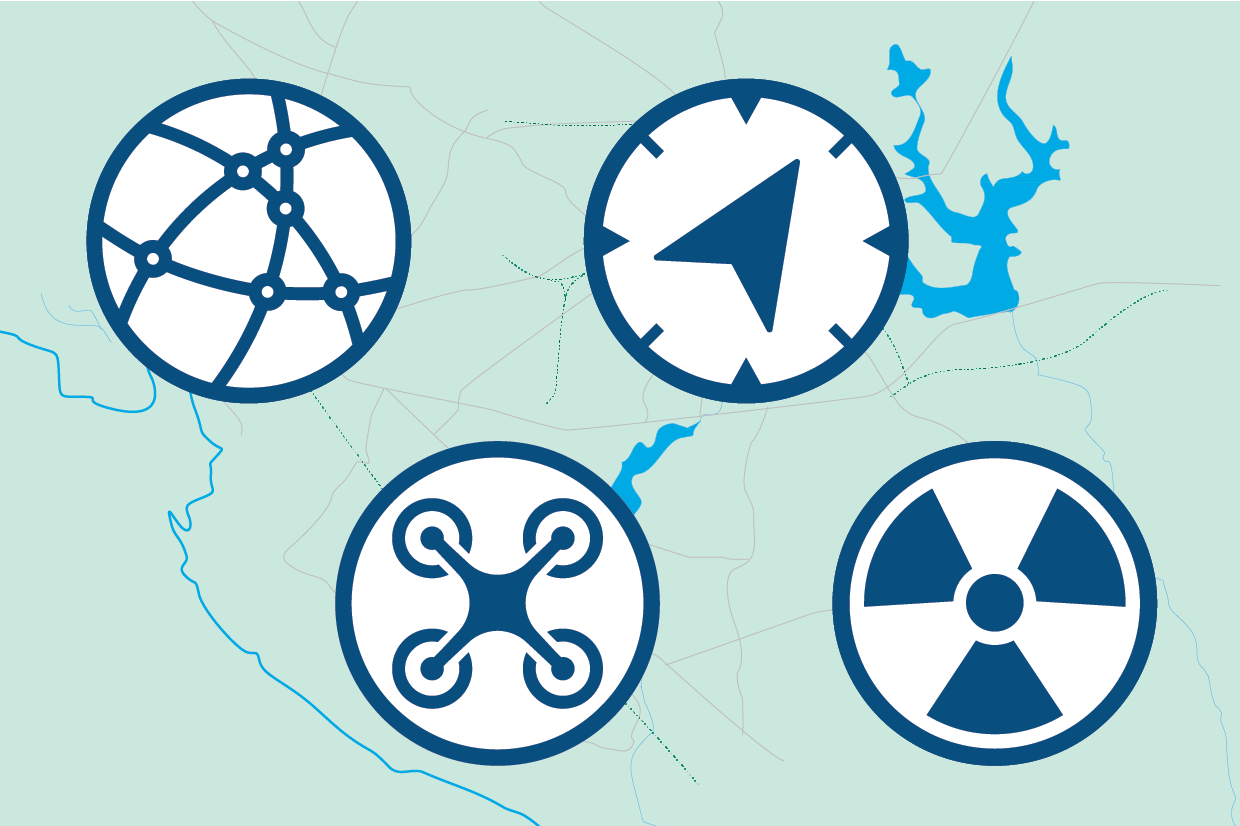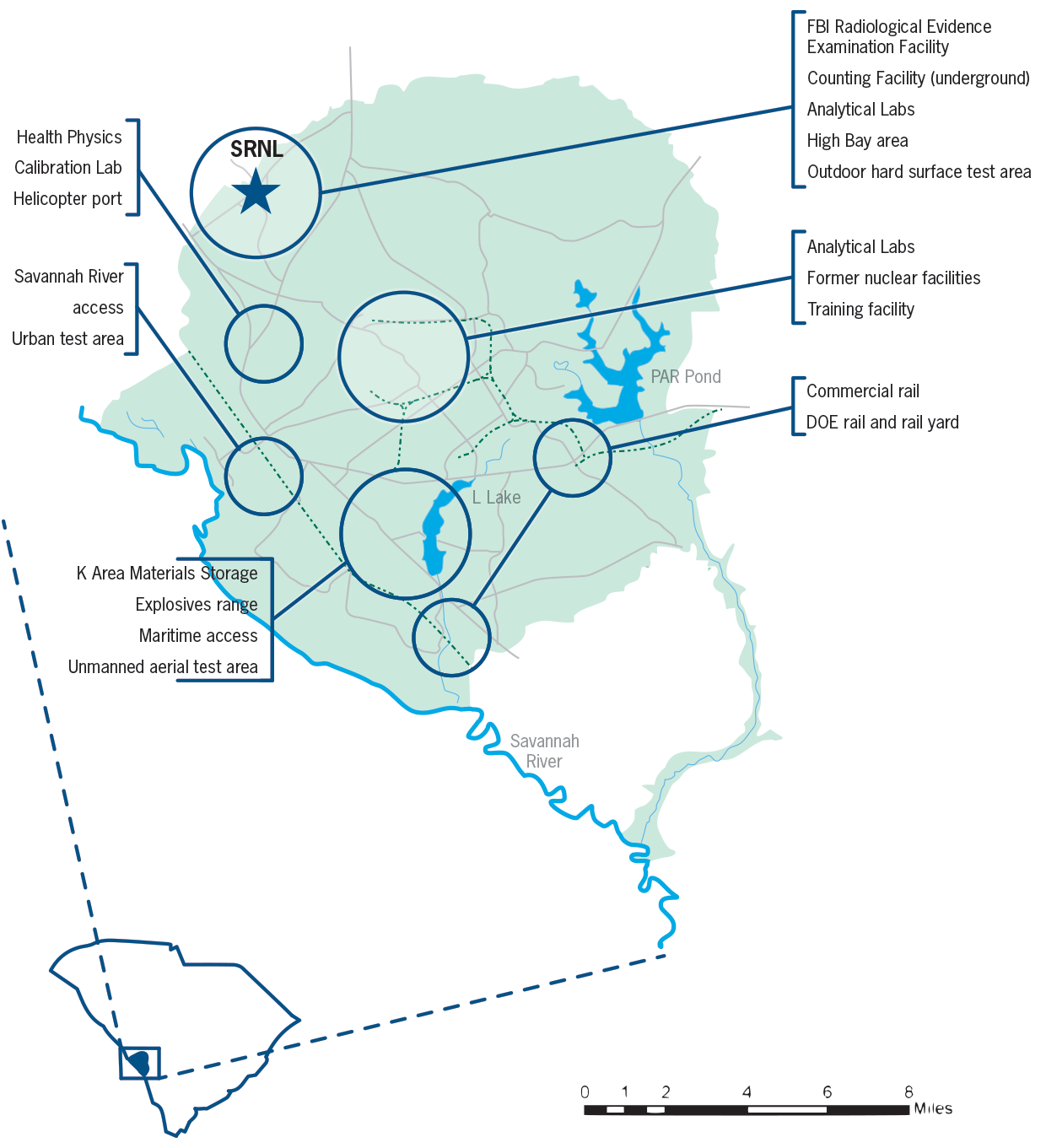Developing the Advanced Technology Proving Ground to Support National Security Missions
“We are leveraging the legacy facilities and locations at Savannah River Site that’s been a critical component of the nation’s national security posture for 75 years.” – Marc Taylor

Graphic by Susanna King, SRNL.
Grounds for Development
What has the same area as the circumference of the Washington, D.C. beltway and offers unique topography, a subtropical climate, existing infrastructure, and fortified facilities, all within a secured boundary? If one is familiar with the history of the Central Savannah River Area in Georgia and South Carolina and the Cold War, the Department of Energy Savannah River Site (SRS) comes to mind.
Created in 1950 for plutonium and tritium production in support of nuclear weapons during the Cold War, SRS consists of approximately 310 square miles in a relatively remote location along the Savannah River in South Carolina. The massive infrastructure needed for such a huge undertaking required a large area to provide the required security footprint and allow for public safety requirements. Today, SRS provides a unique opportunity to conduct a wide variety of testing and evaluation for national security missions in a protected boundary having high humidity and a dense foliage environment for open-air experiments. In addition, the massive Cold War legacy facilities provide an unrivaled indoor test capability for “zero-observable” requirements.
Department of Energy laboratories, sites and facilities throughout the United States play a significant role in technology advancement, testing and evaluation, as well as training of personnel from other government agencies. Over the past two decades, the preference for technology development and training exercises were with sites having predominantly desert or high-desert geography. Political and social circumstances have significantly changed, and the current need focuses on threat representative geography and topology found in the Southeast United States.
Proof in Certainty and Concept
As the research and development (R&D) and test/evaluation (T/E) organization on the SRS, Savannah River National Laboratory (SRNL) is developing the Advanced Technology Proving Ground (ATPG)* to support technology development and training for a wide variety of national security missions using existing infrastructure, facilities and areas of SRS. The site’s unique location provides access to the Savannah River, is home to two large lakes, and features 610 miles of roadways that cut across both open terrain and heavily forested areas. Additionally, decommissioned nuclear facilities, special nuclear material storage areas, rail yards, 17-miles of isolated transmission lines and more allow endless testing and training environments for any situation.
“We are leveraging the legacy facilities and locations at Savannah River Site that’s been a critical component of the nation’s national security posture for 75 years,” said Marc Taylor, SRNL Department of Defense portfolio manager. We’re looking to continue this position for another 75 years to complete critical missions for the good of the nation.”
Ethan Farquhar, director of the Advanced Technology and Analysis Division of the SRNL Global Security Directorate, says the goal of the ATPG is to repurpose what he refers to as “national treasures” for current and future national and energy security missions. He cites the 17 miles of isolated transmission lines and C-Reactor as examples of existing infrastructure/facilities that SRNL could develop to support research focusing on grid security and resiliency. “We have lots of infrastructure and components here that we could use to create and test the grid of the future,” said Farquhar. “SRS has unique physical assets that could enable testing that’s not necessarily available in one particular place around the country.”
While building the grid of the future at SRS is currently only a concept, many opportunities and capabilities are certain and real. The open-air test range in P Area includes 1,500 acres centrally located within the secured SRS boundary. The open-air test range capabilities include radio frequency testing, UAS (rotary and fixed wing) exercises, a licensed FCC Experimental Station, a fully Instrumented Meteorological Tower, and land area for search/find missions for radiological and nuclear materials sources. This area, combined with already existing capabilities and labs within SRNL’s main and ancillary locations, is only the beginning for the ATPG. “As our mission scope expands,” said Taylor, “we hope to use and leverage other areas at Savannah River Site for the ATPG, as well.”

The 310-sq. mile Savannah River Site is uniquely suited to the development of a next-generation national security training facility. Graphic by Alphonzo James, SRNL.
*SRNL is considering a name change to the Advanced Technology Proving Ground, as future development plans include it being more than a proving ground for SRNL technologies.
SRNL is focused on two test ranges at SRS: an open-air test range in the P Area of the site, and an indoor test range involving the decommissioned C Reactor. These multi-domain, multi-user training, exercise, and test and evaluation ranges incorporate current and potential future capabilities, including:
Cybersecurity
Radio Frequency Spectrum Test Facility
Industrial Control Systems (ICS)/ Supervisory Control and Data Acquisition (SCADA) Modeling Lab
Electric Grid Vulnerability Lab
Electronic Warfare (Future)
Cyber Wireless Testing and Evaluation (Future)
UAS/C-UAS
FCC Experimental Station License
Rural Operations and Separation from Controlled Airspace
2,500’ x 50’ Paved Runway (partially complete – 1000’ x 50’ paved)
FAA Special Use Airspace: National Security Area (can be restricted under 14CFR 99.7)
Near Sea Level Density Altitude
Beyond Visual Line of Sight Flight Operations
Positioning, Navigation and Timing (PNT) Architecture
Chemical, Biological, Radiological, Nuclear and Energetic (CBRNE)/Countering Weapons of Mass Destruction (CWMD) Materials and Detector Benchmarking
Radiological Material Handling and Packaging Training
Field Exercises for U.S. Government Entities/Agencies
Training and Exercises
Live-sky Conventional Threat (CT) and Emergency Threat
(ET) test environments for fixed and mobile platforms
Resilient Navigation and Timing Solutions Not Solely Dependent on GPS